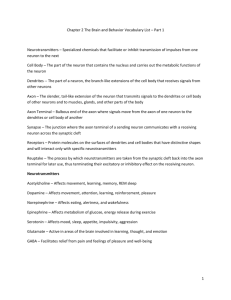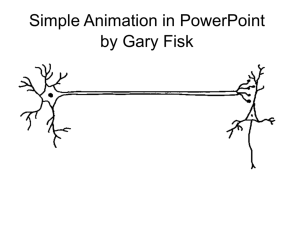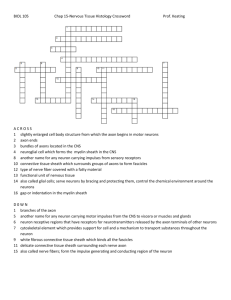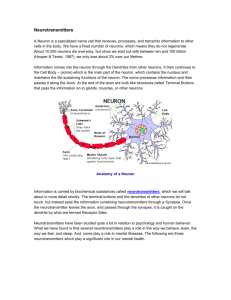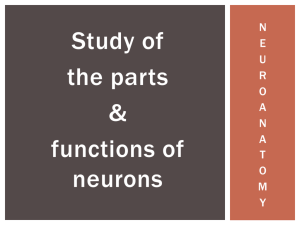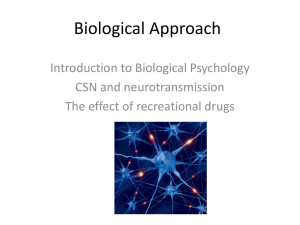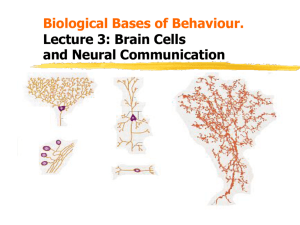File
advertisement
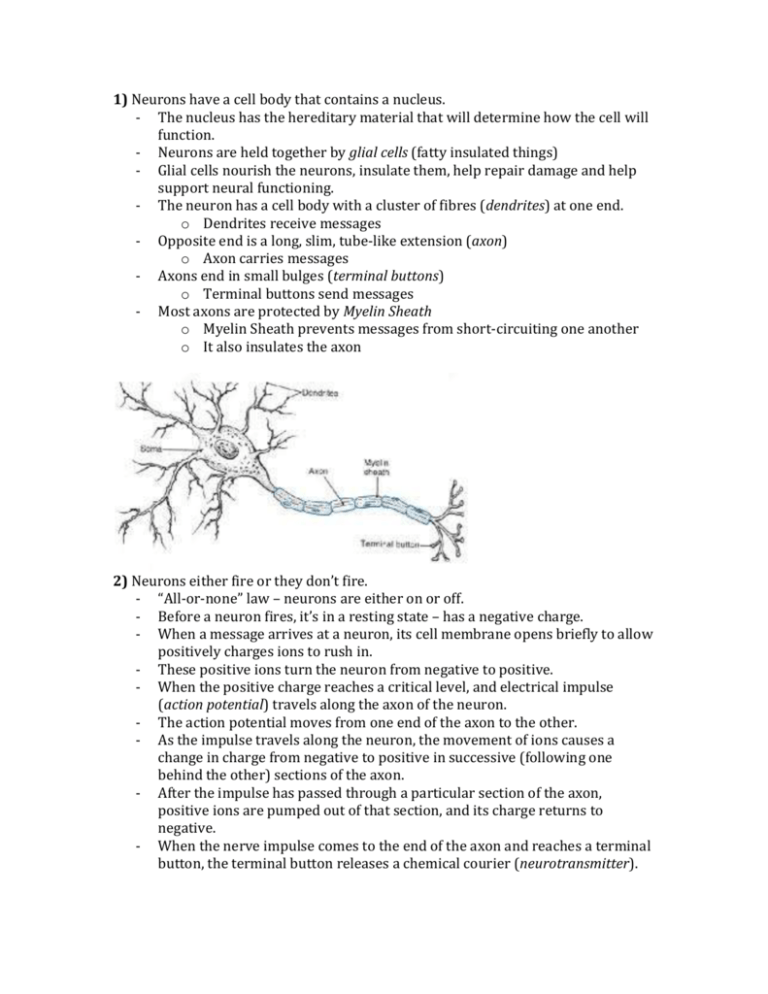
1) Neurons have a cell body that contains a nucleus. - The nucleus has the hereditary material that will determine how the cell will function. - Neurons are held together by glial cells (fatty insulated things) - Glial cells nourish the neurons, insulate them, help repair damage and help support neural functioning. - The neuron has a cell body with a cluster of fibres (dendrites) at one end. o Dendrites receive messages - Opposite end is a long, slim, tube-like extension (axon) o Axon carries messages - Axons end in small bulges (terminal buttons) o Terminal buttons send messages - Most axons are protected by Myelin Sheath o Myelin Sheath prevents messages from short-circuiting one another o It also insulates the axon 2) Neurons either fire or they don’t fire. - “All-or-none” law – neurons are either on or off. - Before a neuron fires, it’s in a resting state – has a negative charge. - When a message arrives at a neuron, its cell membrane opens briefly to allow positively charges ions to rush in. - These positive ions turn the neuron from negative to positive. - When the positive charge reaches a critical level, and electrical impulse (action potential) travels along the axon of the neuron. - The action potential moves from one end of the axon to the other. - As the impulse travels along the neuron, the movement of ions causes a change in charge from negative to positive in successive (following one behind the other) sections of the axon. - After the impulse has passed through a particular section of the axon, positive ions are pumped out of that section, and its charge returns to negative. - When the nerve impulse comes to the end of the axon and reaches a terminal button, the terminal button releases a chemical courier (neurotransmitter). - - - Each neurotransmitter has a distinctive configuration (like a jigsaw puzzle piece) that allows it to fit into a specific type of receptor site on the receiving neuron. o Only when it fits perfectly, is the communication complete. After the neurotransmitter fits, its either an excitatory or inhibitory message. o Excitatory Message: a chemical message that makes a neuron more likely to fire and an action potential will travel down its axon/ o Inhibitory Message: a chemical message that prevents or decreases the likelihood that a neuron will fire. The extra neurotransmitters that remained at the site of the synapse go to reuptake. o Reuptake is the reabsorption of neurotransmitters by a terminal button. 3) Neurotransmitters - Acetylcholine (ACh) o Muscle movement, cognitive functioning - Glutamate o Forming and storing memories - Gamma-amino Butyric Acid (GABBA) o Eating, aggression, sleeping - Dopamine o Muscle disorders, mental disorders, Parkinson’s Disease - Serotonin o Sleeping, eating, mood, pain, depression - Endorphins o Pain suppression, pleasurable feelings, appetites, placebos. 4) Central Nervous System - Brain and spinal cord - Brain controls behaviour - Spinal cord transmits messages between the brain and the body Peripheral Nervous System - Contains all parts of the nervous system other than the brain and the spinal cord - Somatic Division/Autonomic Division o Somatic Division Controls voluntary muscle movements Communicates info to and from sense organs. IE: motion of eyes to read this o Autonomic Division Involuntary, automatic and unconscious movements. You don’t think about doing them. IE: breathing, heartbeat - Subdivides of Autonomic Division – Sympathetic and Parasympathetic Division o Sympathetic Division Prepares the body for action in stressful situations “Fight or flight” response. Adrenaline rush feeling Heart accelerates, digestion slows, pupils widen, sweating o Parasympathetic Division Calms the body after the emergency has ended “Rest and Digest” Brings everything back down Heart slows, digestion increases, pupils constrict, no sweating 5) Central Core - Medulla o Critical body functions/unconscious functions o Heart rate, breathing - Pons o Transmitter of motor information o Muscle coordination, integrates movement between right and left halves of the body, sleep - Cerebellum o Balance - Reticular Formation o Attention and concentration o Makes decisions o Soccer Goalie – concentrates ONLY on the ball - Thalamus o Relay station for information about senses - Hypothalamus o Maintains homeostasis and produces vital basic behaviour Homeostasis = keeping everything in balance o Eating, drinking, sexual behaviour Limbic System - Controls eating, aggression, and reproduction - Self preservation, learning, memory 6) Cerebral Cortex - Frontal Lobe o Planning and organizing ability o Coordinating and initiating complex body movements o Broca’s Area – controls speech production - Parietal Lobe o Somatosensory Strip – responsible for receiving bodily sensations for specific parts of the body - Temporal Lobe o Auditory information is registered o Language 7) – The left hemisphere controls the right side of your body; the right hemisphere controls the left side of your body - Researchers found that people with speech difficulties tended to have physical damage to the left side of the brain. - Physical abnormalities in the right side caused fewer speech problems o Language is lateralized (left side of the brain) Lateralized means its located more in one hemisphere than the other - Left hemisphere o Language, speech, writing, calculation, time sense, rhythm - Right hemisphere o Nonverbal, perceptual skills, visualization, recognition of patterns, faces, melodies - Split Brain – corpus callosum cut surgically - Right and left hemispheres specialize in handling different sorts of information o However, both are capable of understanding, knowing and being aware of the world, just in different ways. 8) Endocrine System - Made up of glands that secrete chemicals directly into the blood stream of the lymph system. o Chemicals = hormones

